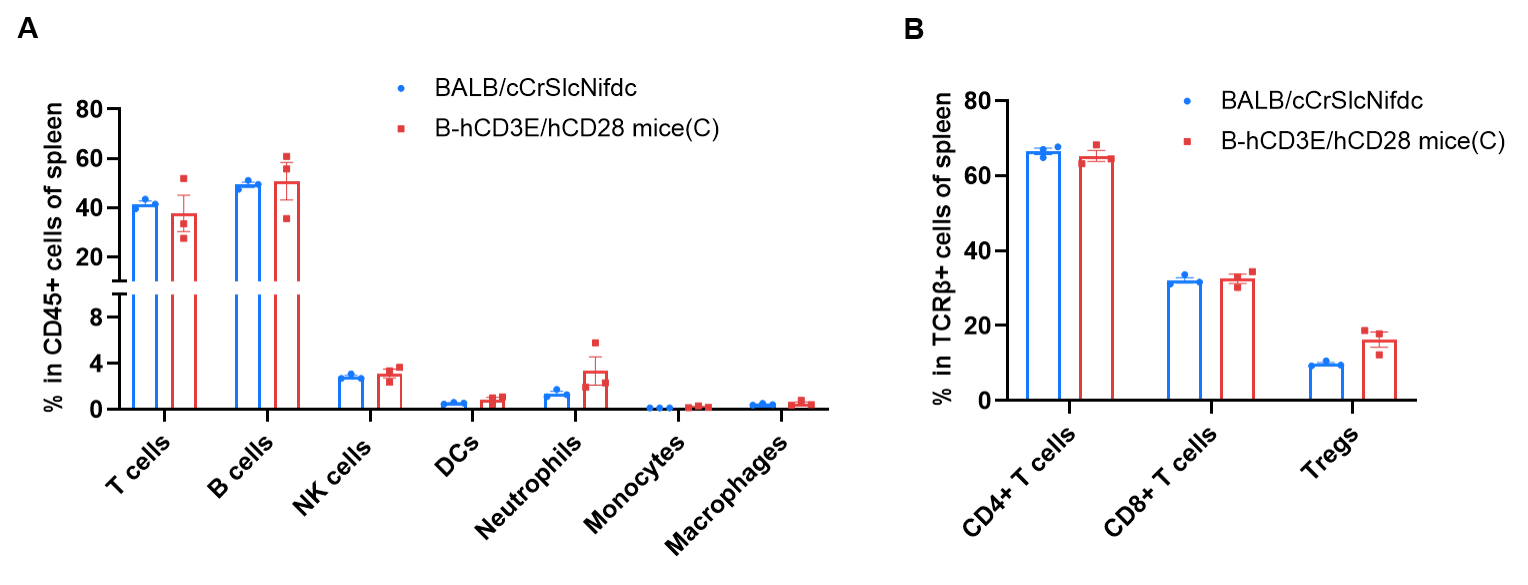
BALB/cCrSlcNifdc-Cd3etm2(CD3E)Bcgen Cd28tm1(CD28)Bcgen/Bcgen • 112960
Gene targeting strategy for B-hCD3E/hCD28 mice(C).
The exons 2-6 of mouse Cd3e gene that encode the extracellular domain were replaced by human CD3E exons 2-7 in B-hCD3E/hCD28 mice(C).
The exons 2-3 of mouse Cd28 gene that encode extracellular domain were replaced by human counterparts in B-hCD3E/hCD28 mice(C). The genomic region of mouse Cd28 gene that encodes transmembrane domain and cytoplasmic portion was retained. The promoter, 5’UTR and 3’UTR region of the mouse gene were also retained. The chimeric CD28 expression was driven by endogenous mouse Cd28 promoter, while mouse Cd28 gene transcription and translation will be disrupted.

CD3E expression analysis in wild-type BALB/cCrSlcNifdc mice and homozygous humanized B-hCD3E/hCD28 mice(C) by flow cytometry. Spleen T cells were collected from wild-type BALB/cCrSlcNifdc mice (+/+) and homozygous B-hCD3E/hCD28 mice(C) (H/H; H/H) (Female, 6-week-old, n=1). Protein expression was analyzed with anti-human CD3E antibody (BD Horizon™, 562426) and anti-mouse CD3E antibody (Biolegend, 100312) by flow cytometry. Human CD3E was exclusively detectable in homozygous B-hCD3E/hCD28 mice(C), but not in wild-type BALB/cCrSlcNifdc mice.

Strain specific CD28 expression analysis in homozygous B-hCD3EhCD28 mice(C) by flow cytometry. Splenocytes were collected from wild-type BALB/cCrSlcNifdc mice (+/+) (Female, 6-week-old, n=1) and B-hCD3EhCD28 mice(C) (H/H) (Female, 6-week-old, n=1). Cells were stimulated in vivo via intraperitoneal injection of 7.5 μg/mouse anti-CD3ε antibodies (anti-mouse CD3ε: clone 145-2C11, BioXCell BE0001-1; anti-human CD3ε: clone OKT3, BioXCell BE0001-2) for 24 hours. Protein expression was analyzed with anti-mouse CD28 antibody (Biolegend, 102105) and anti-human CD28 antibody (Biolegend, 302912) by flow cytometry. mCD28 was detectable in wild-type mice, hCD28 was detectable in B-hCD3EhCD28 mice(C).

Frequency of leukocyte subpopulations in spleen by flow cytometry. Splenocytes were isolated from wild-type BALB/cCrSlcNifdc mice (female, n=3, 8-week-old), homozygous B-hCD3E/hCD28 mice(C) (female, n=3, 8-week-old). A. Flow cytometry analysis of the splenocytes was performed to assess the frequency of leukocyte subpopulations. B. Frequency of T cell subpopulations. Percentages of T cells, B cells, NK cells, dendritic cells, neutrophils, monocytes, macrophages, CD4+ T cells, CD8+ T cells and Tregs in B-hCD3E/hCD28 mice(C) were similar to those in BALB/cCrSlcNifdc. Values are expressed as mean ± SEM. Significance was determined by two-way ANOVA test. *P < 0.05, **P < 0.01, ***p < 0.001.